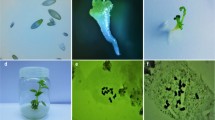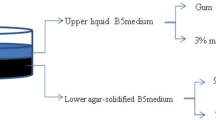Abstract
A novel approach for chromosome doubling that consists of treating embryos instead of parts of micropropagated plants was investigated. Following 2-year trials, amiprofos-methyl (APM) was found to be superior to oryzalin on the basis of a lower toxicity, and we were able to narrow the range of concentrations of APM. The addition of 2% dimethyl sulphoxide (DMSO) and 1% Triton X-100 to 25 μM APM had no effect in all treatments. A final experiment with 6,658 embryos demonstrated that a 2-day treatment in liquid media supplemented with 50 μM APM was the most successful with respect to chromosome doubling—36.7% of the plants were diploid—but the survival rate was reduced to 52.5% of that of the non-treated control. A 2-day treatment in liquid medium supplemented with 25 μM APM or a 2-day treatment on solid medium with 50 μM APM resulted in the production of diploids at a frequency of 28.9% and 21.3%, respectively. These may represent alternative methods for chromosome doubling since compared to the untreated control these two treatments reduced the survival rate by only about 24%. Final ploidy and fertility of the large proportion of induced mixoploid plants (up to 30.3%) need to be evaluated in further studies.

Similar content being viewed by others
References
Bohanec B (2002) Doubled-haploid onions. In: Rabinowitch H, Currah L (ed) Allium crop science: recent advances. CABI, Wallingford, pp 145–157
Bohanec B, Jakše M (1997) Characteristics of onion haploid induction procedure. In: Proc 1st Congr Genet Soc Slovenia. Ljubljana, Slovenia, pp 47–49
Bohanec B, Jakše M (1999) Variations in gynogenic response among long-day onion (Allium cepa L.) accessions. Plant Cell Rep 18:737–742
Bohanec B, Jakše M, Javornik B (2001) Present status of haploid induction in onion: analysis of procedure and its limitations. In: Armstrong (ed) Proc Sec Int Symp Edible Alliaceae. Acta Hortic 555:91–98
Campion B, Perri E, Azzimonti MT, Vicini E, Schiavi M (1995) Spontaneous and induced chromosome doubling in gynogenic lines of onion (Allium cepa L.). Plant Breed 114:243–246
Dunstan DI, Short KC (1977) Improved growth of tissue cultures of onion, Allium cepa L. Physiol Plant 41:70–72
Geoffriau E, Kahane R, Bellamy C, Rancillac M (1997a) Ploidy stability and in vitro chromosome doubling in gynogenic clones of onion (Allium cepa L.). Plant Sci 122:201–208
Geoffriau E, Kahane R, Rancillac M (1997b) Variation of gynogenesis ability in onion (Allium cepa L.). Euphytica 94:37–44
Hansen NJP, Andersen SB (1998) In vitro chromosome doubling with colchicine during microspore culture in wheat (Triticum aestivum L.). Euphytica 102:101–108
Hansen AL, Gertz A, Joersbo M, Andersen SB (1998) Antimicrotubule herbicides for in vitro chromosome doubling in Beta vulgaris L. ovule culture. Euphytica 101:231–237
Jakše M, Bohanec B (2000) Studies of alternative approaches for genome doubling in onion. In: Bohanec B (ed) Biotechnological approach: utilization of gametic cells. COST 824 final meeting, Bled, Slovenia pp 101–104
Nowak E (2000) Gynogenic onion plants—studies on regeneration and diploidization. In: Bohanec B (ed) Biotechnological approach: utilization of gametic cells. COST 824 final meeting, Bled, Slovenia, pp 95–99
Rao PS, Suprasanna P (1996) Methods to double haploid chromosome numbers. In: Mohan Jain S, Sopory KS, Veilleux RE (ed) In vitro haploid production in higher plants. Kluwer, Dordrecht, pp 317–339
Tosca A, Pandolfi R, Citterio S, Fasoli A, Sgorbati S (1995) Determination by flow cytometry of the chromosome doubling capacity of colchicine and oryzalin in gynogenetic haploids of gerbera. Plant Cell Rep 14:455–458
Wan Y, Duncan DR, Rayburn AL, Petolino JF, Widholm JM (1991) The use of antimicrotubule herbicides for the production of doubled haploid plants from anther-derived maize callus. Theor Appl Genet 81:205–211
Author information
Authors and Affiliations
Corresponding author
Additional information
Communicated by H. Lörz
Rights and permissions
About this article
Cite this article
Jakše, M., Havey, M.J. & Bohanec, B. Chromosome doubling procedures of onion (Allium cepa L.) gynogenic embryos. Plant Cell Rep 21, 905–910 (2003). https://doi.org/10.1007/s00299-003-0595-8
Received:
Revised:
Accepted:
Published:
Issue Date:
DOI: https://doi.org/10.1007/s00299-003-0595-8




